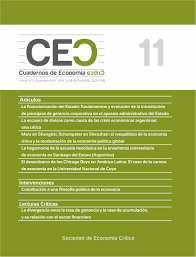La Foreing exchange insufficiency as a cause of Argentine economic crises:
a critic
Keywords:
economic cycles, economic crises, balance of payments crisis, external constraintAbstract
The article critically reviews the idea that Argentina's balance of payments crises originate in the existence of a "structural" shortage of currencies. We will analyze several authors who defended this approach in the postwar period. Three conclusions are remarkable. The first is that this thesis is based on an inappropriate diagnosis of the causes of this shortage. The second is that its economic policy proposals, limited to the field of foreign trade, avoid any intervention on the main factors of currency outflow. Finally, more than a theory about barriers to internal growth, the argument of an “external restriction” can be characterized as an attempt to reconcile this growth with a type of international insertion that is clearly unbalanced in terms of the external sector of the economy.
Keywords: economic cycles; economic crises; balance of payments crisis; external constraint.
Downloads
References
Braun, O. (1973). Desarrollo del capital monopolista en la Argentina (pp. 73-118). En Braun, O. (comp.) El Capitalismo Argentino en Crisis. México: Siglo Veintiuno.
Brodersohn, M. (1974). Política económica de corto plazo, crecimiento e inflación en la Argentina 1950-1972 (pp. 3-64). En Problemas Económicos Argentinos. Diagnóstico y Política. Buenos Aires: Ediciones Macchi.
Canitrot, A. (1975). La experiencia populista de redistribución de ingresos. Desarrollo Económico, (59), 331-351.
Canitrot, A. (1983). El salario real y la restricción externa de la economía. Desarrollo Económico, 23(91), 423-427.
Diamand, M. (1973). Doctrinas Económicas, Desarrollo e Independencia. Economía para las Estructuras Productivas Desequilibradas. Caso Argentino. Buenos Aires: Editorial Paidós.
Diamand, M. (1983). El péndulo argentino: ¿hasta cuándo? Conferencia sobre medidas de cambio político económico en América Latina. Vanderblit University, Nashville, Tennesse, Estados Unidos. Recuperado de: https://docs.google.com/viewerng/viewer?url=http://psocialista.org/economia/wp-content/uploads/2016/07/diamand.pdf&hl=es
Díaz Alejandro, C. F. (1966). Devaluación de la Tasa de cambio en un País Semi-industrializado. La Experiencia de la Argentina 1955-1961. Buenos Aires: Editorial del Instituto.
Díaz Alejandro, C. F. (1970). Ensayos sobre la historia económica argentina. Buenos Aires: Amorrortu.
Ferns, H. (1950). Investment and trade between Britain and Argentina in the nineteenth century. The Economic History Review, 3(2), 203-218.
Ferreres, O. (2010). Dos Siglos de Economía Argentina 1810 2010. Buenos Aires: Fundación Norte y Sur.
Mallon, R. y Sourrouille, J. (1973). La Política Económica en una Sociedad Conflictiva. El Caso Argentino. Buenos Aires: Amorrortu.
Prebisch, R. (1993). La relación entre el ciclo argentino y el ciclo monetario internacional (pp. 319-329). En Prebisch, R. Obras 1919-1948, t. III, cap. 110. Buenos Aires: Fundación Raúl Prebisch. Trabajo original publicado en 1944.
Schvarzer, J. (1996). La Industria que Supimos Conseguir. Una Historia Político-social de la Industria Argentina. Buenos Aires: Planeta.
Sourrouille, J. (1978). La presencia y el comportamiento de las empresas extranjeras en el sector industrial argentino. Buenos Aires: CEDES.
Sourrouille, J. y Kosacoff, B. (1979). Sobre la evolución del contenido de importaciones intermedias en la demanda final y las exportaciones argentinas: un ejercicio en insumo-producto. Desarrollo Económico, (72), 597-606.
Villanueva, J. (1969). Aspectos de la estrategia de industrialización argentina (pp. 325-355). En Di Tella, T. y Halperin Donghi, T. [eds.] Los Fragmentos del Poder. De la Oligarquía a la Poliarquía Argentina. Buenos Aires: Editorial Jorge Alvarez SA.
Published
Versions
- 2021-01-07 (5)
- 2021-01-05 (4)
- 2021-01-05 (3)
- 2021-01-04 (2)
How to Cite
Issue
Section
License
Copyright (c) 2019 Gustavo Burachik

This work is licensed under a Creative Commons Attribution-NonCommercial-NoDerivatives 4.0 International License.
Copyright notice
Authors retain copyright and grant the journal the right to be the first publication of the work as licensed under a Creative Commons Attribution License that allows others to share the work with an acknowledgement of authorship of the work and initial publication in this journal.
Authors may separately enter into additional arrangements for non-exclusive distribution of the version of the work published in the journal (e.g., placing it in an institutional repository or publishing it in a book), with an acknowledgement of initial publication in this journal.
Authors are allowed and encouraged to disseminate their work electronically (e.g. in institutional repositories or on their own website) before and during the submission process, as it may lead to productive exchanges, as well as earlier and higher citation of published work (see The Effect of Open Access).























